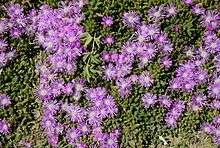Delosperma cooperi
| Delosperma cooperi | |
|---|---|
 | |
| Scientific classification | |
| Kingdom: | Plantae |
| (unranked): | Angiosperms |
| (unranked): | Eudicots |
| (unranked): | Core eudicots |
| Order: | Caryophyllales |
| Family: | Aizoaceae |
| Genus: | Delosperma |
| Species: | D. cooperi |
| Binomial name | |
| Delosperma cooperi (Hook.f.) L.Bolus | |
Delosperma cooperi (syn. Mesembryanthemum cooperi; common names Trailing Iceplant or "Pink Carpet") is a dwarf perennial plant, native to South Africa. It forms a dense lawn with abundant, long-lasting flowering. It will reach sizes of approximately 10–15 cm (4–6 in) tall, with fleshy leaves and a trailing stem that hangs down.
The flowers are the most brilliant aspect of this plant, with the production of a great quantity of vermillion, magenta or pink flowers that will often cover the entire site, hence the popular name "pink carpet". The plant contains ramified stems that are spread out, carrying sheets opposed, and are long and narrow, with the end of the stems increasing into a quantity of isolated small flowers, with diameters ranging from 3 to 5 cm (1 to 2 in). These abundant and long-lasting flowers will remain in bloom from July through September. The plant is sun-loving, and thrives well in very dry and hot environments. While it adapts well to various soil types, it will suffer under water stagnation, and thus prefers well drained soils, or even rocky terrain.
According to the New Mexico State University extension, the common name, "ice plant" is because "they have bladder-like hairs on the leaf surface that reflect and refract light in a manner to make it appear that they sparkle like ice crystals" (or tiny glass beads). However, many other species of succulent so-called "ice plant" ground covers have smooth and hairless leaves.
Cultivation and uses
It can be cultivated in a wide range of areas with a Mediterranean climate. Unlike many ice plants, this species is hardy to −20 °F (−29 °C). The leaves turn red in cold winter temperatures. Due to the low need for maintenance, it is suitable for urban environments and high temperature regions. It can often be found in large, extensive patches. The trailing stems also make it suitable for flowerpots and terraces.
Propagation is easy. Just take a cutting without a flower on. Strip a couple of bottom leaves off then replant in same soil. Will become established very quickly.
Sources
- Leistner, O. A. (ed.). 2000. Seed plants of southern Africa: families and genera. Strelitzia 10. National Botanical Institute, Pretoria.
- Smith, G. F.; Chesselet, P.; Van Jaarsveld, E. J.; Hartmann, H.; Hammer, S.; Van Wyk, B.-E.; Burgoyne, P.; Klak, C.; & Kurzweil, H. 1998. Mesembs of the world. Briza Publications, Pretoria.
| Wikispecies has information related to: Delosperma cooperi |
| Wikimedia Commons has media related to Delosperma cooperi. |